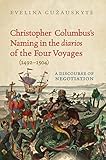Christopher Columbus's Naming in the 'diarios' of the Four Voyages (1492-1504) : A Discourse of Negotiation / Evelina Guzauskyte.
Material type: TextSeries: Toronto IbericPublisher: Toronto : University of Toronto Press, [2014]Copyright date: ©2014Description: 1 online resource (296 p.) : 13 b&w illustrations, 1 b&w tableContent type:
TextSeries: Toronto IbericPublisher: Toronto : University of Toronto Press, [2014]Copyright date: ©2014Description: 1 online resource (296 p.) : 13 b&w illustrations, 1 b&w tableContent type: - 9781442647466
- 9781442668249
- 972.9/02 23
- E118 .G89 2014eb
- online - DeGruyter
| Item type | Current library | Call number | URL | Status | Notes | Barcode | |
|---|---|---|---|---|---|---|---|
 eBook
eBook
|
Biblioteca "Angelicum" Pont. Univ. S.Tommaso d'Aquino Nuvola online | online - DeGruyter (Browse shelf(Opens below)) | Online access | Not for loan (Accesso limitato) | Accesso per gli utenti autorizzati / Access for authorized users | (dgr)9781442668249 |
Browsing Biblioteca "Angelicum" Pont. Univ. S.Tommaso d'Aquino shelves, Shelving location: Nuvola online Close shelf browser (Hides shelf browser)
Frontmatter -- Contents -- Illustrations -- Acknowledgments -- Abbreviations -- Introduction -- 1. “Named Incorrectly”: The Geographic and Symbolic Functions of Columbian Place Names -- 2. Words and the World: The Known Corpus of Columbian Place Names -- 3. “Y saber dellos los secretos de la tierra”: Taino Toponymy and Columbian Naming -- 5. Iguana and Christ -- 6. Infernal Imagery: Spirituality and Cosmology in the Final Two Voyages -- Conclusion -- Appendix: A Comprehensive List of Columbian Place Names -- Notes -- Bibliography -- Index -- Backmatter
restricted access online access with authorization star
http://purl.org/coar/access_right/c_16ec
In this fascinating book, Evelina Gužauskytė uses the names Columbus gave to places in the Caribbean Basin as a way to examine the complex encounter between Europeans and the native inhabitants.Gužauskytė challenges the common notion that Columbus’s acts of naming were merely an imperial attempt to impose his will on the terrain. Instead, she argues that they were the result of the collisions between several distinct worlds, including the real and mythical geography of the Old World, Portuguese and Catalan naming traditions, and the knowledge and mapping practices of the Taino inhabitants of the Caribbean. Rather than reflecting the Spanish desire for an orderly empire, Columbus’s collection of place names was fractured and fragmented – the product of the explorer’s dynamic relationship with the inhabitants, nature, and geography of the Caribbean Basin.To complement Gužauskytė’s argument, the book also features the first comprehensive list of the more than two hundred Columbian place names that are documented in his diarios and other contemporary sources.
Mode of access: Internet via World Wide Web.
In English.
Description based on online resource; title from PDF title page (publisher's Web site, viewed 01. Dez 2023)









